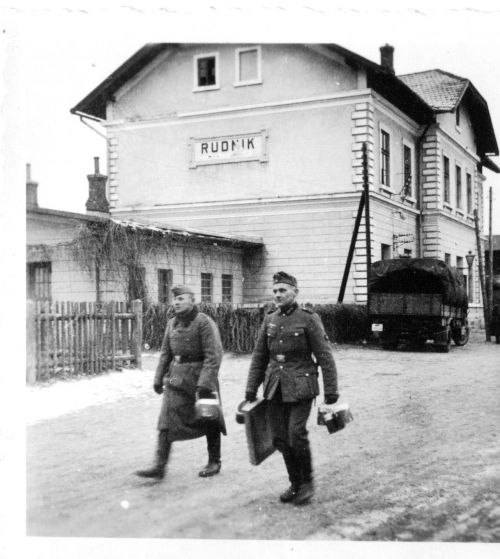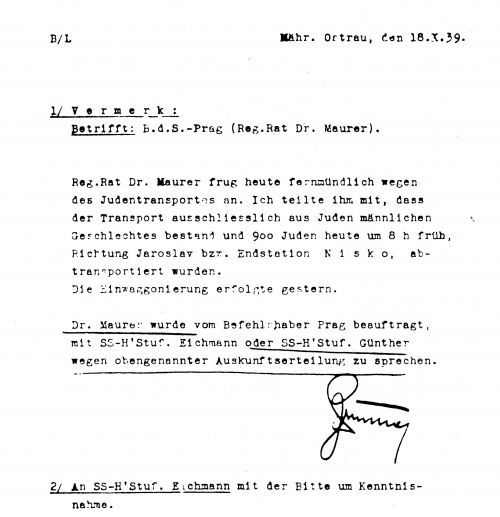Nisko - Resettlement from the Reich

Rudnik bei Nisko - German soldiers at the station (Tall Trees Archive)
Lublin Province received Jews from Bohemia, Vienna and Stettin. This was part of an ill-advised scheme by which 40,000 Baltic Germans were to go to Bohemia, in order to create a German belt between the Czechs and the Slovaks. Not less than 70,000 Czech peasants were uprooted, as well as 12,000 to 20,000 Jews dwelling in the towns of Teschen, Mahrish-Ostrau, Bohumin and Brunn. The number of Germans who took their place was small and out of proportion. They were mostly Reich Germans of the industrial and clerical ranks.
The original exchange scheme provided that the displaced Czech and Viennese Jews should be moved to an agricultural reserve in Eastern Poland, was a plan that originated by Dr. Franz Walther Stahlecker, and Adolf Eichmann. Stahlecker was Eichmann's superior in the Reich Security Main Office, and later went on to command Einsatzkommando A, on the eastern front.
The first settlement was to be near the small town of Nisko, west of the River San and south of Lublin. The first transport left Mahrisch- Ostrau on October 12, 1939. It carried building materials for Nisko, and German construction engineers as well as settlers. At first, the scheme received publicity in the German press, but this was soon dropped. The settlers were forced to build a labour camp for themselves. In a classic case of Nazi terminology of deception, the camp was given the name, 'Central Office for Jewish Resettlement.'

Nisko Endstation Document 18 -X- 1939 - Gestapo Jewish Affairs Department
One of the members from this transport, Max Burger, later recalled: 'The Jews deported from Moravska Ostrava were put into railway coaches- passenger coaches - on October 17. The coaches were placed under SS guard, locked and sealed. On October 18, the train began to move. No water was available, and when, at Krakow station, those in the train pleaded for water, and Poles on the platform wished to help them, Stormtroopers chased away the Poles with rifle blows.
On reaching Nisko station, in the Lublin region, all engineers, builders and doctors, among the deported Jews were ordered to leave the train. Because the doors of the train were sealed, they had to clamber out through the windows. Then surrounded by SS guards, they found themselves among other Jews, who had been deported from Prague and Vienna.
A German officer then addressed them. He was Adolf Eichmann, now in charge of Jewish resettlement, as he had earlier been in charge of emigration. 'About seven or eight kilometres from here,' Eichmann told them, 'across the River San, the Fuhrer of the Jews has promised a new homeland. There are no apartments and no houses - if you will build your homes, you will have a roof over your head. There was no water, Eichmann added. 'The wells are full of epidemics, there's cholera, dysentery and typhus. If you dig for water, you'll have water.'
The deported Jews were then sent across a pontoon bridge to the 'resettlement region.' Once there, such luggage, as they had been able to bring, was opened and German soldiers just took whatever they wanted. Thousands of other Jews soon arrived: elderly Jews from Vienna. Jews who had been captured trying to escape from Moravska Ostrava to Prague. Jews caught on the outbreak of war at Hamburg docks, waiting to board ship for the United States of America, as well as Jews from the port city of Stettin.
Jews resettlers in Nisko later on managed to relocate to the Lublin ghetto, or indeed were returned to Vienna and Moravska Ostrava, whilst the vast majority of the original 4,000 deportees had crossed into the Soviet territory.
Sources
M. Gilbert, The Holocaust, William Collins, London 1986
G. Reitlinger, The Final Solution, published by Sphere Books Ltd, London 1971
Photograph -Tall Trees Archive
Document - Wiener Library
© Holocaust Historical Society 2019

